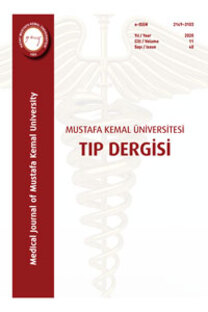ANTAKYA DEVLET HASTANESİNDE GRİGGS TEKNİĞİ İLE PERKÜTAN DİLATASYONEL TRAKEOSTOMİ DENEYİMLERİMİZ; 168 OLGU
Amaç: Son 20 yılda yoğun bakım hastalarındaperkütan dilatasyonal trakeostomi (PDT)uygulaması standart açık cerrahi tekniğe oranlaartmıştır. Biz bu çalışmada Griggs tekniği ileyapılan PDT uygulamalarımızı sunmayıamaçladık.Gereç ve Yöntem: Ocak 2010 ile aralık 2012arasında Antakya devlet hastanesinde PDTuygulanan 168 hasta retrospektif olarakdeğerlendirildi. Hastaların demografik verileri,Akut ve Kronik Fizyolojik SağlıkDeğerlendirme skorları (APACHE II), vitalparametreleri, mekanik ventilasyon (MV)süreleri, entübasyon süreleri, işlem süreleri veyatış tanıları kaydedildi. Erken dönemkomplikasyonlar olarak minör kanama, majorkanama, subkutan amfizem, pnömotoraks,desaturasyon, aritmi ve trakeal hasar ele alındı.Bulgular: Yatış tanısı olarak en fazla oranda71 hastada(%42) ateşli silah yaralanmalarıolduğu görüldü. Erken dönem komplikasyonoranı % 15.4 iken minör kanamalar 16 hasta ile(%9.5) en sık olarak bulundu. 2 hastada (%1.2)major kanama tespit edildi. Ortalama girişimsüresi 8.9 dk, entübasyon süresi 6.7 olarakbulundu. 5 hastada (%2.9) desaturasyongörüldü ve erken dönemde düzeldi. 1 hastada(%0.6) ise ciltaltı amfizem gelişti.Sonuç: Yoğun bakımda yatak başı uygulananPDT işlemi basit, hızlı ve güvenlidir ve çok azciddi komplikasyon oranına sahiptir.
Anahtar Kelimeler:
yoğun bakım, perkütan dilatasyonal trakeostomi, griggs tekniği
Experience Of Our Percutaneous Dılatatıonal Tracheostomy By Usıng Grıggs Technıque At Antakya State Hospıtal; 168 Cases
Aim: During the last two decades the use ofpercutaneous dilatational tracheostomy (PDT)in critically ill patients has been increasedinstead of the standard open surgery technique.In this study we aimed to present our PDTpractices by using Grigg’s tecnique.Material and Method: The data of 168patients who were performed PDT by usingGriggs technique at Antakya State Hospitalbetween january 2010 and december 2012,were analyzed retrospectively. Demographicdatas of patients, APACHE II scores,entubation time, vital parameters, mechanicventilation time, the pocedure time, diagnosisof patients were recorded. Minor bleeding,major bleeding, subcutaneous emphysema,pneumothorax, desaturation, arrhythmia anddamage of the trachea were recorded as earlycomplications of the procedure.Results: Gunshot injuries are the mostcommon admissional diagnosis in 71 (42%)patients. The rate of early complication was15.4% and minor bleeding was the commonwith 16 (9.5%) patients. 2 patients (%1.2) hadmajor bleeding. Mean procedure time was 8.9min. and mean entubation time was 6.7 days. 5patients (2.9%) had desaturation and improvedin early period. Subcutaneous emphysemaocurred in one patient (0.6%).Conclusion: PDT is a simple, quick, and safeprocedure at the bedside in intensive care unitand has low serious complication rates.
___
- 1. Griggs WM, Worthley LIG, Gilligan JE, Thomas PD, Myberg JA. A simple percutaneous tracheostomy tecnique. Surg Gynecol Obstet. 1990;170:543-5.
- 2. Griggs WM, Myburgh JA, Worthley LIG. A prospective comparison of a percutaneous tracheostomy technique with standard surgical tracheostomy. Intensive Care Med. 1991;17:261-3.
- 3. Angel LF, Simpson CB. Comparison of surgical and percutaneous dilatational tracheostomy. Clin Chest Med. 2003;24:423-9.
- 4. Crofts SL, Alzeer A, McGuire GP, et al. A comparison of percutaneous and operative tracheostomies in intensive care patients. Can J Anaesth. 1995;42:775-79.
- 5. Hutchinson RC, Mitchell RD. Life-threatening complications from percutaneous dilatational tracheostomy. Crit Care Med. 1991;19:118-20.
- 6. Griffiths J, BarberVS, Morgan L, Young JD. Systematic review and meta-analysis of studies of the timing of tracheostomy in adult patients undergoing artificial ventilation. BMJ. 2005;330:1243.
- 7. Disayabutr S, Tscheikuna J, Tangsujaritvijit V, Nana A. Experience of percutaneous dilatational tracheostomy by using Grigg’s technique in Siriraj Hospital. J Med Assoc Thai. 2013;96:22-8.
- 8. Pietkiewicz P, Machala W, Kusmierczyk K, Milonski J, Wisniewski T, Urbaniak J et al. Early complications of Griggs percutaneous tracheotomy in the own material. Otolaryngol Pol. 2012;66(3):196-200.
- 9. Van Heurn LW,Van Geffen GJ, Brink PR. Clinical experience with percutaneous dilatational tracheostomy: report of 150 cases. Eur J Surg. 1996;162:531-5.
- 10. Kearney PA, Griffen MM, Ochoa JB, Boulanger BR, Tseui BJ, Mentzer RM. A snglecenter 8-year experience with percutaneous dilatational tracheostomy. Ann Surg. 2000;231;701-9.
- 11. Çiçek M, Gedik E, Yücel A, Köroğlu A, Ersoy MÖ. Griggs tekniği ile açılan perkütan trakeostomi sonuçlarımız. İnönü Üniversitesi Tıp Fak. Dergisi. 2007;14(1):17-20.
- 12. Friedman Y, Fildes J, Benitone J. Comparison of percutaneous and surgical tracheostomies. Chest. 1996;110:480-5.
- 13. Hazard P, Jones C, Benitone J. Comperative clinical trial of Standard operative tracheostomy with percutaneous tracheostomy. Crit Care Med. 1991;19:1018-24.
- ISSN: 2149-3103
- Yayın Aralığı: Yılda 3 Sayı
- Başlangıç: 2010
- Yayıncı: Hatay Mustafa Kemal Üniversitesi Tıp Fakültesi Dekanlığı
Sayıdaki Diğer Makaleler
GEÇİCİ HEMODİYALİZ KATETER UYGULAMALARIMIZ
Ümit Halıcı, Mehmet Kayğın, Özgür Dağ, Hüsnü Limandal, Ümit Arslan, Adem Kıymaz, Ahmet Aydın, Bilgehan Erkut
Füsun AYDOĞAN, Erhan YENGİL, Nilgül ÜSTÜN, Raif ÖZDEN, Mehmet HELVACI
KLARİTROMİSİNE BAĞLI GELİŞEN AKUT PANKREATİT
M. ÇELİK, Mehmet DEMİR, Melda BULGURCU, Ali KARAKUŞ, Gamze KAVVASOĞLU
Mustafa Özgür, Celalettin Dağlı, Fatma Ceylan, Harun Atıcı, Murat Karcıoğlu
ENSEFALOMALAZİK GÖRÜNÜMLÜ GLİABLASTOME MULTİFORME: OLGU SUNUMU
S. BAŞARSLAN, Cüneyt GÖÇMEZ, Abdülkerim GÖKOĞLU, Ahmet MENKÜ
